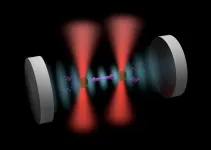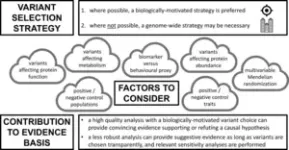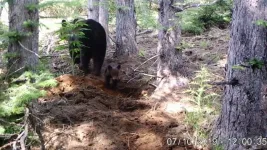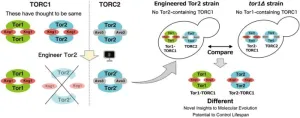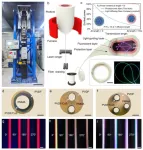(Press-News.org) The question of where the boundary between classical and quantum physics lies is one of the longest-standing pursuits of modern scientific research and in new research published today, scientists demonstrate a novel platform that could help us find an answer.
The laws of quantum physics govern the behaviour of particles at miniscule scales, leading to phenomena such as quantum entanglement, where the properties of entangled particles become inextricably linked in ways that cannot be explained by classical physics.
Research in quantum physics helps us to fill gaps in our knowledge of physics and can give us a more complete picture of reality, but the tiny scales at which quantum systems operate can make them difficult to observe and study.
Over the past century, physicists have successfully observed quantum phenomena in increasingly larger objects, all the way from subatomic particles like electrons to molecules which contain thousands of atoms.
More recently, the field of levitated optomechanics, which deals with the control of high-mass micron-scale objects in vacuum, aims to push the envelope further by testing the validity of quantum phenomena in objects that are several orders of magnitude heavier than atoms and molecules. However, as the mass and size of an object increase, the interactions which result in delicate quantum features, such as entanglement, get lost to the environment, resulting in the classical behaviour we observe.
But now, the team co-led by Dr Jayadev Vijayan, Head of the Quantum Engineering Lab at The University of Manchester, with scientists from ETH Zurich, and theorists from the University of Innsbruck, have established a new approach to overcome this problem in an experiment carried out at ETH Zurich, published in the journal Nature Physics.
Dr Vijayan said: “To observe quantum phenomena at larger scales and shed light on the classical-quantum transition, quantum features need to be preserved in the presence of noise from the environment. As you can imagine, there are two ways to do this- one is to suppress the noise, and the second is to boost the quantum features.
“Our research demonstrates a way to tackle the challenge by taking the second approach. We show that the interactions needed for entanglement between two optically trapped 0.1-micron-sized glass particles can be amplified by several orders of magnitude to overcome losses to the environment.”
The scientists placed the particles between two highly reflective mirrors which form an optical cavity. This way, the photons scattered by each particle bounce between the mirrors several thousand times before leaving the cavity, leading to a significantly higher chance of interacting with the other particle.
Johannes Piotrowski, co-lead of the paper from ETH Zurich added: “Remarkably, because the optical interactions are mediated by the cavity, its strength does not decay with distance meaning we could couple micron-scale particles over several millimetres.”
The researchers also demonstrate the remarkable ability to finely adjust or control the interaction strength by varying the laser frequencies and position of the particles within the cavity.
The findings represent a significant leap towards understanding fundamental physics, but also hold promise for practical applications, particularly in sensor technology that could be used towards environmental monitoring and offline navigation.
Dr Carlos Gonzalez-Ballestero, a collaborator from the Technical University of Vienna said: “The key strength of levitated mechanical sensors is their high mass relative to other quantum systems using sensing. The high mass makes them well-suited for detecting gravitational forces and accelerations, resulting in better sensitivity. As such, quantum sensors can be used in many different applications in various fields, such as monitoring polar ice for climate research and measuring accelerations for navigation purposes.”
Piotrowski added: “It is exciting to work on this relatively new platform and test how far we can push it into the quantum regime.”
Now, the team of researchers will combine the new capabilities with well-established quantum cooling techniques in a stride towards validating quantum entanglement. If successful, achieving entanglement of levitated nano- and micro-particles could narrow the gap between the quantum world and everyday classical mechanics.
At the Photon Science Institute and the Department of Electrical and Electronic Engineering at The University of Manchester, Dr Jayadev Vijayan’s team will continue working in levitated optomechanics, harnessing interactions between multiple nanoparticles for applications in quantum sensing.
-Ends-
END
Scientists make nanoparticles dance to unravel quantum limits
2024-03-01
ELSE PRESS RELEASES FROM THIS DATE:
Study identifies multi-organ response to seven days without food
2024-03-01
New findings reveal that the body undergoes significant, systematic changes across multiple organs during prolonged periods of fasting. The results demonstrate evidence of health benefits beyond weight loss, but also show that any potentially health-altering changes appear to occur only after three days without food.
The study, published today in Nature Metabolism, advances our understanding of what’s happening across the body after prolonged periods without food.
By identifying the potential health benefits from fasting ...
New microbiome insights could help boost immunotherapy for a range of rare cancers
2024-03-01
The microbiome can identify those who benefit from combination immunotherapy across multiple different cancers, including rare gynaecological cancers, biliary tract cancers and melanoma.
Researchers from the Wellcome Sanger Institute, the Olivia Newton-John Cancer Research Institute in Australia, and collaborators, have identified specific strains of bacteria that are linked with a positive response to combination immunotherapy in the largest study of its kind.
The study, published today (1 March) in Nature Medicine, details a signature collection of microorganisms in an individual’s gut bacteria that may help identify those who would benefit from combination immunotherapy and ...
It’s not only opposites that attract – new study shows like-charged particles can come together
2024-03-01
A study published today in Nature Nanotechnology shows that similarly charged particles can sometimes attract, rather than repel.
The team found that like-charged particles suspended in liquids can attract one another at long-range, depending on the solvent and the sign of the charge.
The study has immediate implications for processes that involve interactions in solution across various length-scales, including self-assembly, crystallisation, and phase separation.
‘Opposites charges attract; like charges repel’ is a fundamental principle of basic physics. But a new study from Oxford University, published today in Nature Nanotechnology, has demonstrated that similarly ...
Japanese wolves are most closely related to dogs and share DNA with East Eurasian dogs
2024-03-01
In this study, we determined nine genomes of Japanese wolves and 11 genomes of modern Japanese dogs at high coverage and analyzed with one hundred dog and wolf genomes in the public database. The analyses showed that 1) the Japanese wolf was a unique subspecies of the gray wolf that is genetically distinct from both extant and ancient gray wolves known to date, 2) the Japanese wolf is most closely related to the monophyletic group of dogs. Furthermore, 3) Japanese wolf ancestry has introgressed into the ancestor of East Eurasian dogs at an early stage of the dog’s history ...
Brown bears digging up artificial forests
2024-03-01
Brown bears foraging for food in the Shiretoko Peninsula of Hokkaido, Japan, have been disrupting tree growth in artificial conifer forests, according to a new study. Researchers compared soil and tree samples from human-forested plots with samples from natural forests. They found that the bears’ digging for cicada nymphs damaged tree roots and altered the nitrogen content of the soil, which in turn limited the diameter growth of trees. The phenomena of bears digging for cicadas, an unusual food source, appears to be restricted to human-planted conifer forest; diversely vegetated natural forest ...
Innovative domain-adaptive method enables 3D face reconstruction from single depth images
2024-03-01
Reconstructing a 3D face from visuals is crucial for digital face modeling and manipulation. Traditional methods predominantly depend on RGB images, which are susceptible to lighting variations and offer only 2D information. In contrast, depth images, resistant to lighting changes, directly capture 3D data, offering a potential solution for robust reconstructions. Recent studies have turned to deep learning for more robust reconstruction from depth data; however, the scarcity of real depth images with accurate 3D facial labels has hindered the training process. Attempts to use auto-synthesized data for training have met limitations ...
Groundbreaking study unveils unique roles of yeast protein complexes in cellular lifespan and environmental response by rationally engineering based on the predicted three-dimensional structures
2024-03-01
Assistant Professor Takahiro Kosugi of Institute for Molecular Science, assistant Professor Yoshiaki Kamada at National Institute for Basic Biology, and colleagues have developed an advanced molecular cell biology approach by integrating computational redesigning of protein complexes based on the predicted three-dimensional structure into yeast genetics. They revealed that two types of protein complexes in yeast, which were thought to have the same function, play distinct roles in cellular environmental response and lifespan. Furthermore, ...
Mass-produced, commercial promising multicolored photochromic fiber
2024-03-01
Fiber, as the wearable material with the longest application in the history of humankind, is currently an ideal substrate for wearable devices due to its excellent breathability, flexibility, and ability to adapt perfectly to the 3D irregular shape of the human body. As a means of visualization in the field of functional fibers, light-emitting fiber breaks the rigidity of the traditional display interface and is expected to become an emerging interaction interface. The current commercial light-emitting fibers are polymer optical fibers and Corning® Fibrance® light-diffusing fibers. These fibers ...
General Medical Council urged to revise terminology for international medical graduates
2024-03-01
The General Medical Council (GMC) should revise its terminology regarding international medical graduates (IMGs) in the UK, argues a new commentary published in the Journal of the Royal Society of Medicine (JRSM).
The existing terminology used by the GMC fails to encompass the full spectrum of doctors facing challenges in the UK medical workforce, according to the paper’s author, Professor Mo Al-Haddad of Queen Elizabeth University Hospital, Glasgow.
Notably, he says, the GMC's definition of IMGs overlooks ...
Prostate cancer test may lead to harmful overdiagnosis in black men
2024-03-01
A new study from experts at the University of Exeter has found that a widely used test for prostate cancer may leave black men at increased risk of overdiagnosis.
Prostate-specific antigen (PSA) testing is routinely used as the first step in the UK to investigate men with urinary symptoms such as blood in urine or urinating very frequently. Men aged over 50 years without symptoms are also able to request the blood test from their GP.
The new study, published in BMC Medicine, sought to investigate the performance of the PSA test in identifying prostate cancer among men ...
